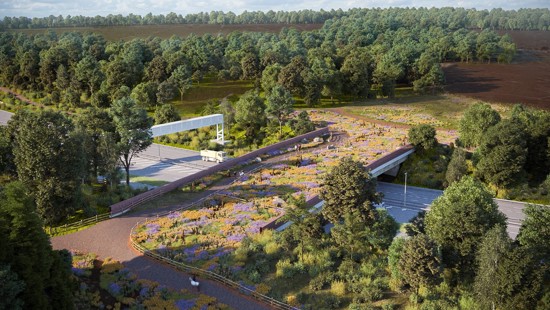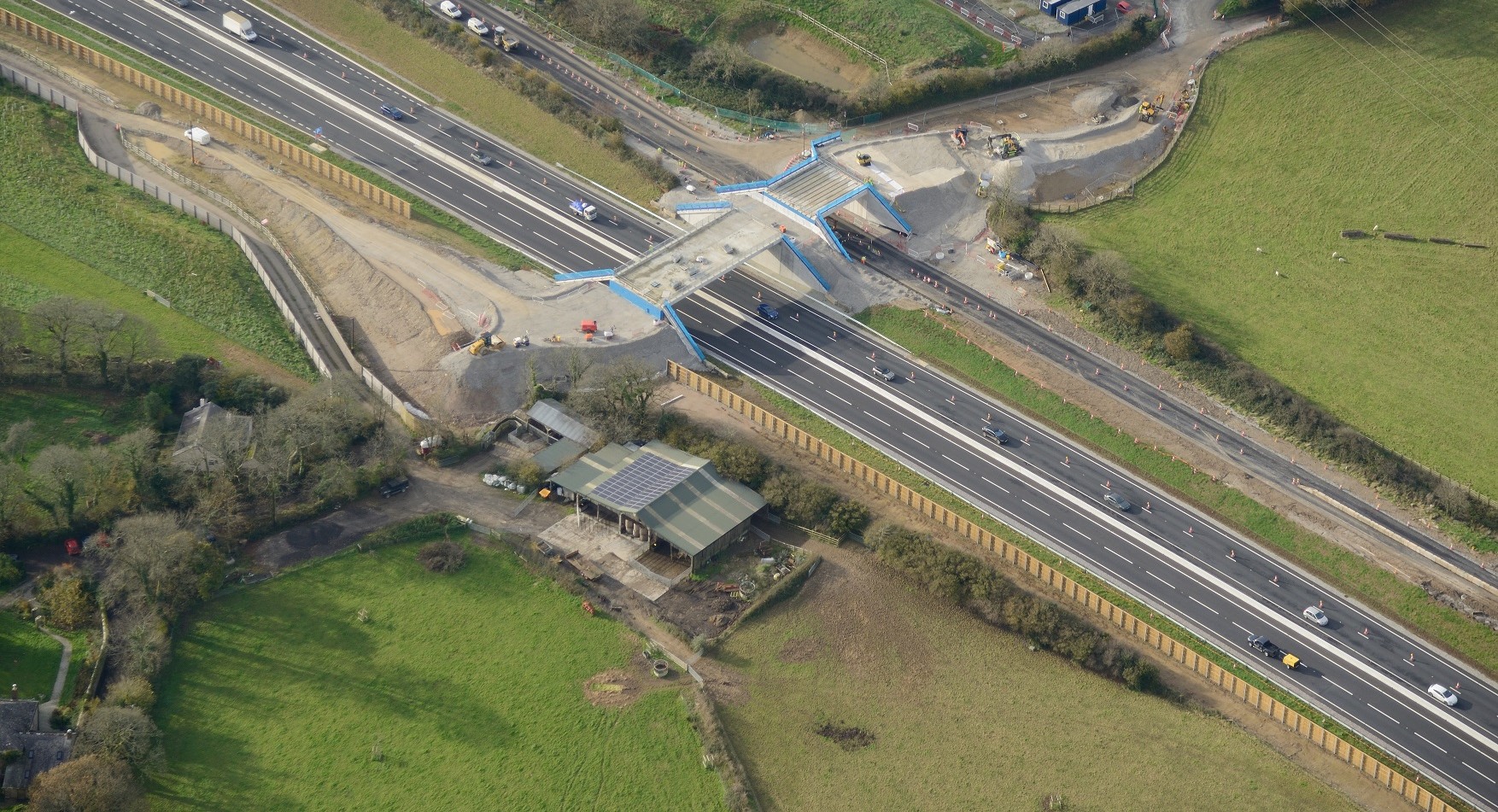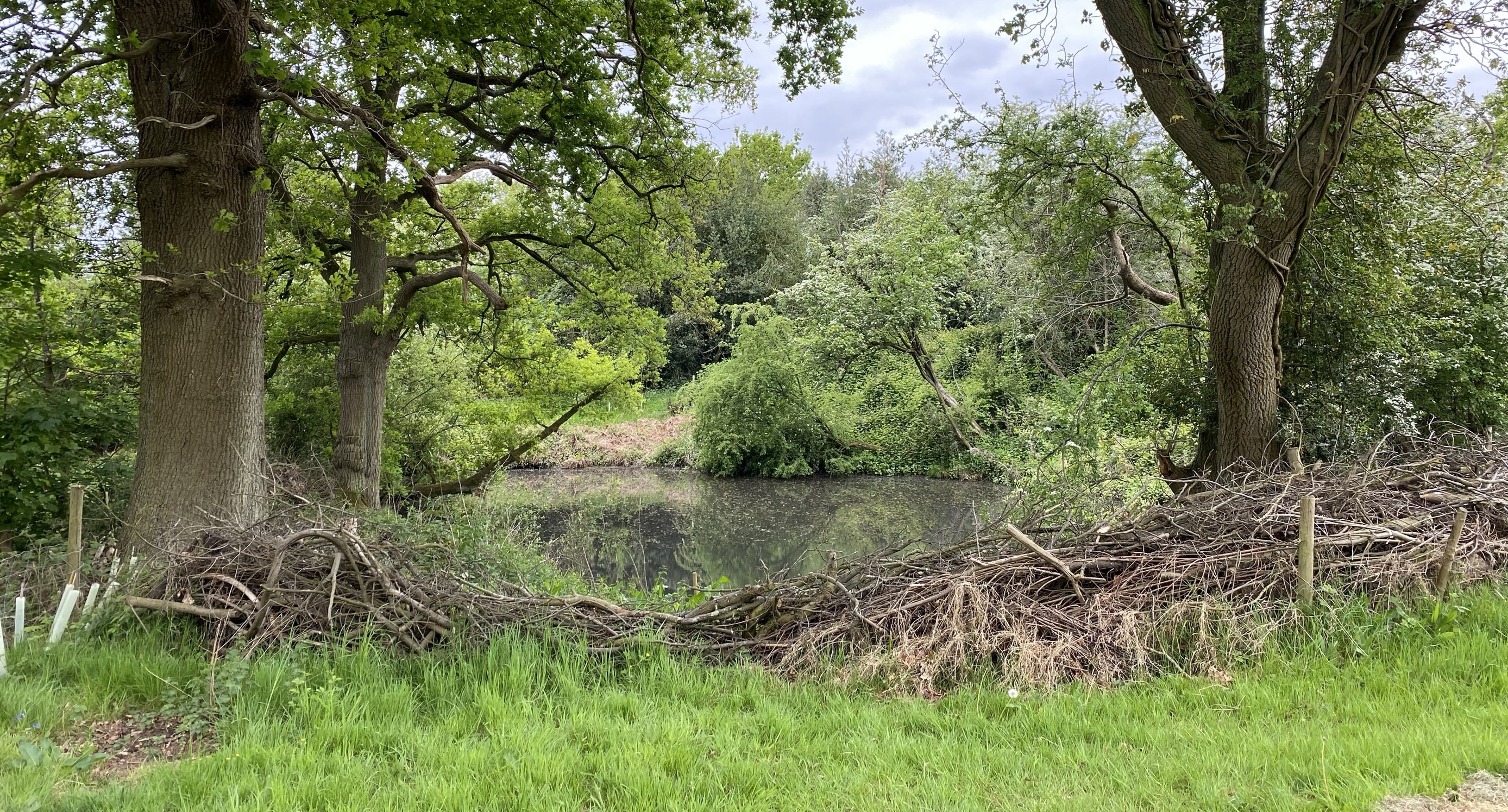National Highways increasing palette of green bridges

National Highways is busy preparing to increase its stock of green bridges across the country.
With only a handful of green, wildlife-friendly bridges sited across the UK, National Highways is set to double its structures across the Strategic Road Network within the next two years
The company, responsible for England’s major A roads and motorways, has already constructed green bridges over the A556 near Chester and the A21 at Scotney Castle in Kent, with three structures to follow – across the A30 in Cornwall, one as part of the A417 Missing Link scheme near Gloucester, and another at Wisley in Surrey, as part of the M25 Junction 10 scheme.
Initiated in France in the 1950s and pioneered in the Netherlands in 1990, green bridges are now becoming an important part of the sustainability of infrastructure projects, by:
• creating a safe crossing point for wildlife movement;
• joining up habitats and connecting colonies, and making wildlife populations more resilient;
• creating a safe crossing point for people and improving road safety;
• integrating roads and railways into the surrounding landscape.
As National Highways marks its third Nature Week, Steve Elderkin, Director of Environmental Sustainability, said: “While roads have always connected people and places, they are too often a barrier for nature; severing habitats and contributing to the decline in biodiversity.
“We have been investing in a huge range of nature-focussed enhancements, and at major project level, this includes large-scale engineered or landscape interventions such as building green bridges and helping to restore peatlands and meadows.
“Our green bridges are designed to blend with the landscape and connect habitats, animals and people, leaving a lasting legacy which ensures nature thrives.”
As part of the major A30 Chiverton to Carland Cross dualling project, a dual-deck bridge has been constructed by contractors Costain, with top soiling work starting later this month, turning the bridge from grey to brown, followed by ‘green’ planting in the autumn.
The bridge – 49.3 metres in length and 12.5m wide – will cater for a different type of traffic, providing a flourishing green border and a safe passage across the road for various wildlife species, including badgers, voles and other small animals, insects and birds, as well as a footpath and a bridleway for horse riders.

The Cockrow Bridge, as part of the M25 Junction 10 scheme, will also reconnect habitats separated by the road, and has been designed and engineered to reunite restored heathland on Wisley Common and Ockham Common.
The 68-metre long structure was installed in January and, as with the other bridges, will be earthed over and planted with heathland species to join it up to the surrounding habitats.
On behalf of the government-funded company, Kier will also be lifting in 10 huge steel beams this summer to create the base of an environmental bridge as part of the A417 Missing Link road upgrade.
The bridge deck will follow for the Gloucestershire Way bridge, which, in the future, will serve as a multi-purpose crossing for walkers, cyclists and horse riders, along with various wildlife species, including deer, badgers, voles and other small animals.
The muti-purpose bridge – 60m in length and 37m wide – will span the new dual carriageway and planting will mirror that of the surrounding landscape, including 27 metres of calcareous grassland and hedgerows.
National Highways is one of the largest landowners in England with over 30,000 hectares of green land) and its verges and land provide valuable habitats for wildlife.
To recognise its work, the company is currently marking its own Nature Week, coinciding with the UN International Day of Biodiversity (22 May), and continues to collaborate with the country’s leading wildlife organisations, such as Natural England, The Wildlife Trust, Meadow Makers, Plantlife and the Tree Council.
Mr Elderkin added: “Increasingly we have been working directly with organisations in the conservation sector, including charities and small businesses, and many of these projects have prioritised nature-based solutions, practices which involve working with nature to address climate and human-induced impacts.”

In an £11.56 million Network for Nature programme, National Highways joined forces with The Wildlife Trusts to deliver 40 habitat-enhancing 40 projects, benefitting people, nature and wildlife where the environment has been impacted by activities from previous road building.
Meadow Makers, a biodiversity-boosting project, has also seen the company working with Plantlife and landowners to restore and create 100 hectares of species-rich grasslands across eight locations.
The nature-based solutions, many of which have been delivered through National Highways’ Designated Funds, have included:
- wetland creation and hedgerow planting to boost nature and reduce flooding for the village of Fillongley near the M6 in Warwickshire (pictured above);
- providing fresh water to more than 300 hectares of arable land near the A47 in Norfolk, improving reliance to climate change and creating new wetland habitats;
- restoring 50 hectares of degraded peatland at Shap Fells in Cumbria, restoring nature, capturing carbon and preventing flooding;
- reintroducing bison to the Wilder Blean in Kent, promoting a thriving, biodiverse environment;
- restoring and recreating 15.5 hectares of woodland, orchard, grassland and heathland north of Truro, including the planting of 15,000 native tree species within the mid-Cornwall landscape;
- improving water quality at Stover Country Park alongside the A38 near Newton Abbot, Devon.
· To find out more about National Highways’ environmental work and how the company is championing biodiversity across the Strategic Road Network, click on the company's web page.
And to learn more about its designated funding stream, more information can be found on the company website.
Notes to Editors
National Highways is the wholly government-owned company responsible for modernising, maintaining and operating England’s motorways and major A roads.
Real-time traffic information for England’s motorways and major A roads is available via the Traffic England website, local and national radio travel bulletins, electronic road signs and mobile apps. Local Twitter services are also available.
For further information please contact National Highways' press office (24hrs) on 0844 693 1448 and select the most appropriate option:
Option 1: National enquiries (9am to 5.30pm) and out of hours for urgent enquiriesOption 2: North West (9am to 5.30pm)Option 3: Yorkshire and North East (9am to 5.30pm)Option 4: West Midlands (9am to 5.30pm)Option 5: East Midlands (9am to 5.30pm)Option 6: East (9am to 5.30pm)Option 7: South East (9am to 5.30pm)Option 8: South West (9am to 5.30pm)



